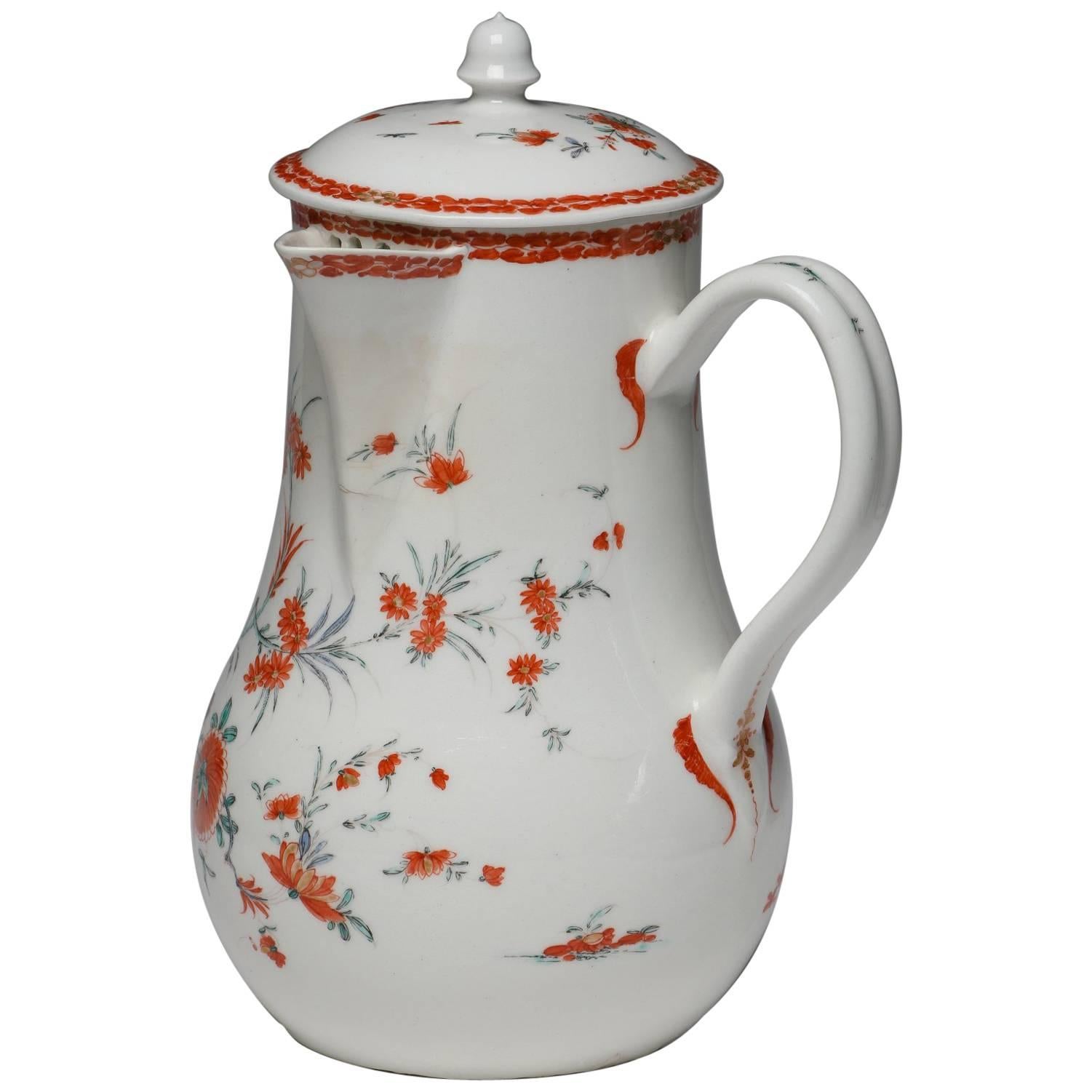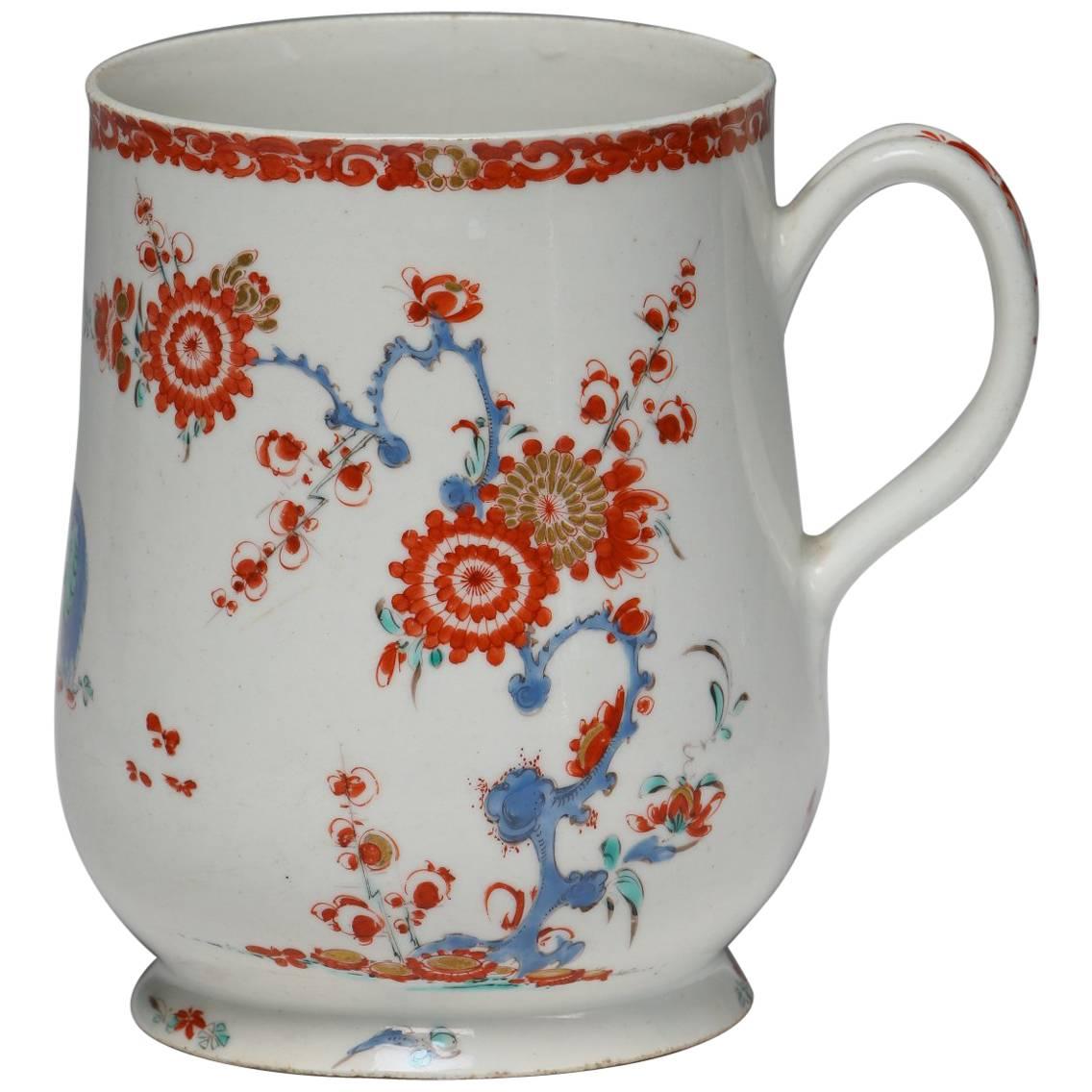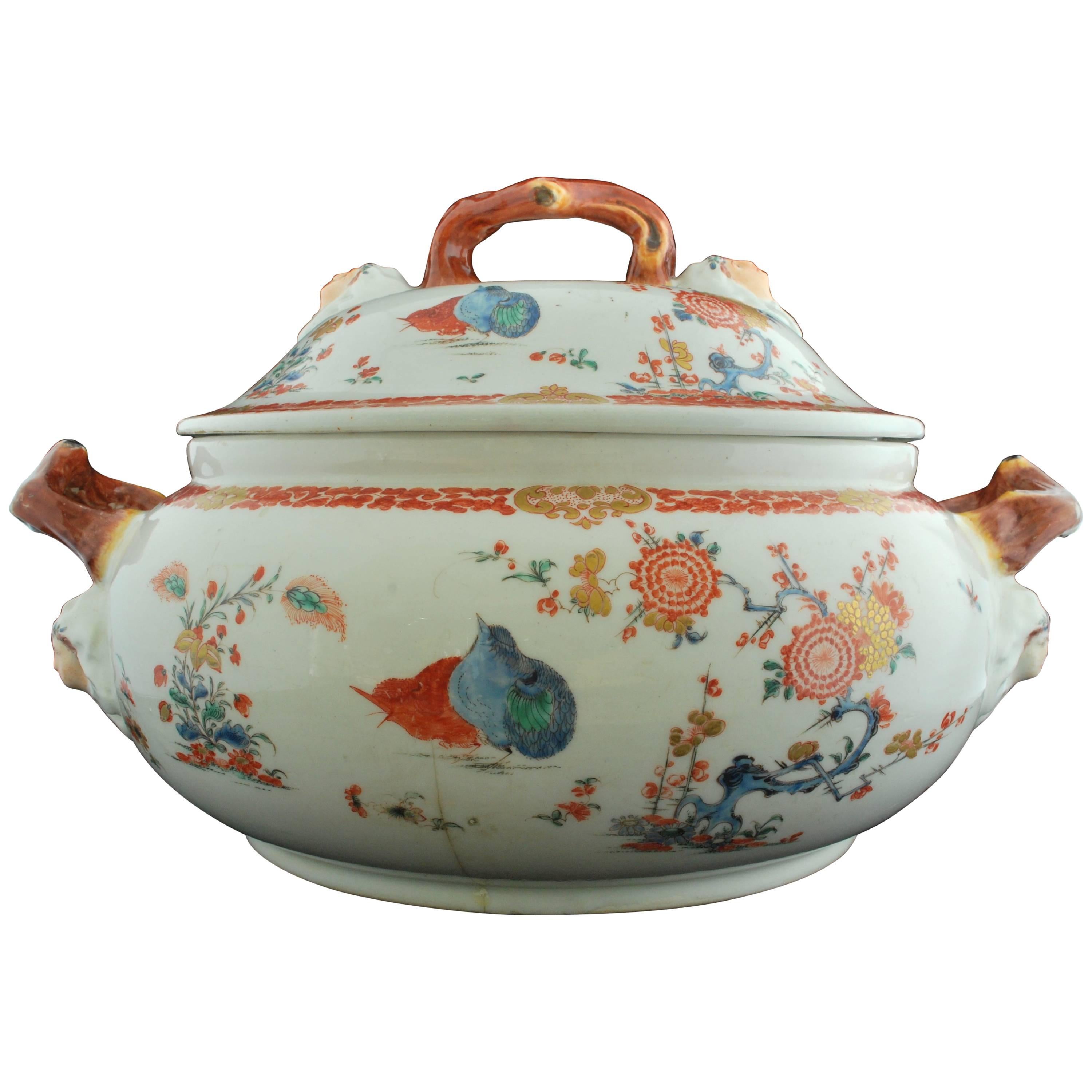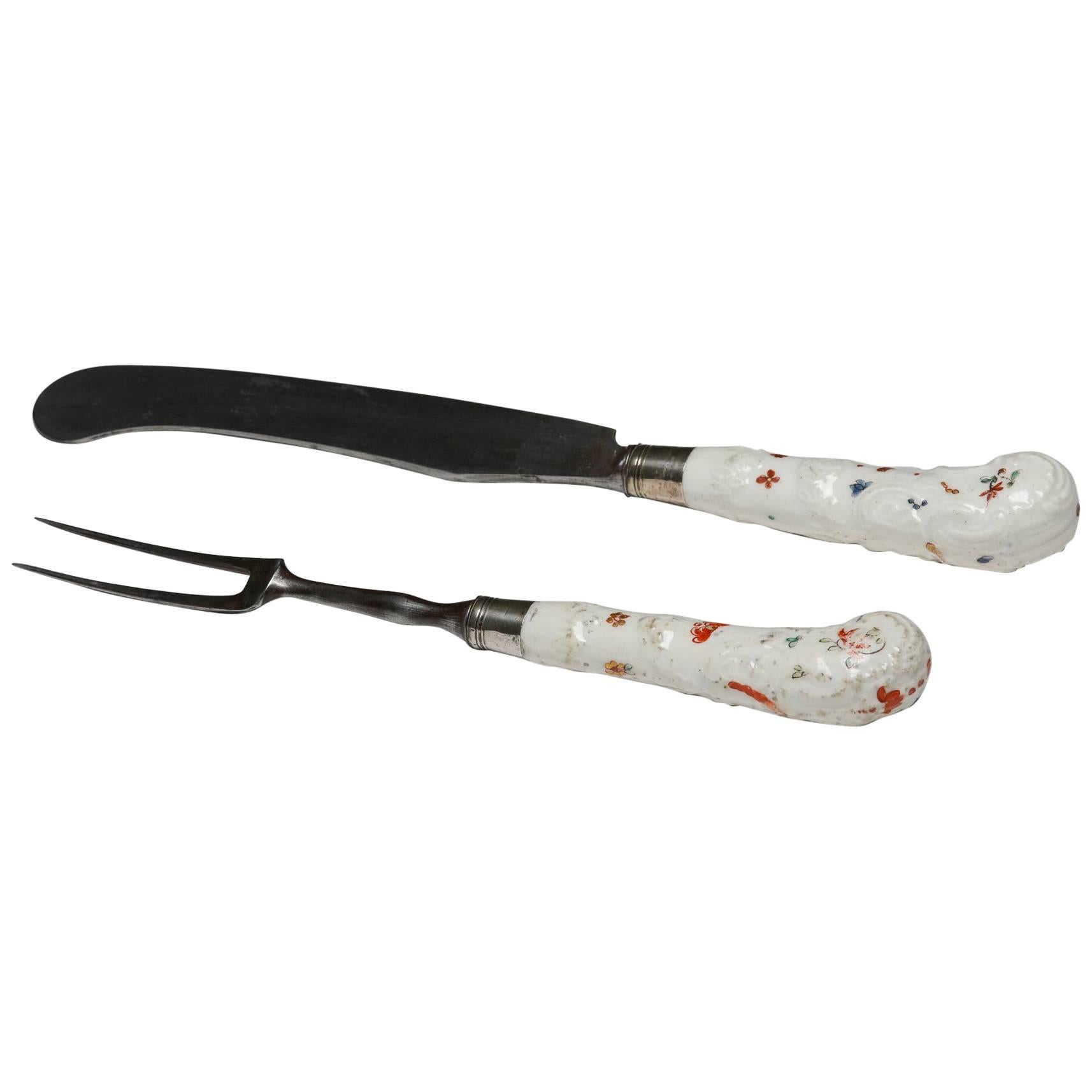Items Similar to Coffee Cup, Kakiemon Decoration, Plymouth, circa 1769
Want more images or videos?
Request additional images or videos from the seller
1 of 6
Coffee Cup, Kakiemon Decoration, Plymouth, circa 1769
About the Item
Coffee cup in hard-paste porcelain, decorated with Kakiemon painting. The fruits of the Plymouth factory are perhaps the first examples of hard-paste porcelain made in England.
- Creator:Plymouth Porcelain Factory 1 (Maker)
- Dimensions:Height: 3 in (7.62 cm)Diameter: 7 in (17.78 cm)
- Style:Japonisme (Of the Period)
- Materials and Techniques:
- Place of Origin:
- Period:
- Date of Manufacture:circa 1769
- Condition:A very small hairline to rim has been invisibly restored.
- Seller Location:Melbourne, AU
- Reference Number:
About the Seller
5.0
Gold Seller
These expertly vetted sellers are highly rated and consistently exceed customer expectations.
Established in 2005
1stDibs seller since 2017
69 sales on 1stDibs
Typical response time: 3 hours
- ShippingRetrieving quote...Ships From: Melbourne, Australia
- Return PolicyA return for this item may be initiated within 14 days of delivery.
More From This SellerView All
- Cup and Saucer, Kakiemon Decoration, Bow Porcelain Factory, circa 1753By Bow PorcelainLocated in Melbourne, VictoriaLow tea cup with clip handle with matching saucer, decorated after the Kakiemon with the two quail pattern. An unusual form with scarce decoration. Prov...Category
Antique Mid-18th Century English Japonisme Porcelain
MaterialsPorcelain
- Chocolate Pot, Kakiemon Decoration, Bow Porcelain Factory, circa 1755By Bow PorcelainLocated in Melbourne, VictoriaOf full-bellied pear-shape with large sparrow-beak lip set slightly below the top rim of the body in front of a triangle of circular pouring holes and at the right angle to the strap...Category
Antique Mid-18th Century English Japonisme Porcelain
MaterialsPorcelain
- Baluster Mug, Kakiemon Decoration, Bow Porcelain Factory, circa 1753By Bow PorcelainLocated in Melbourne, VictoriaPint mug of baluster form with flared base and grooved strap-handle with heart-shaped termination. The face of the mug painted after the Kakiemon with the two Quail pattern. The reve...Category
Antique Mid-18th Century English Japonisme Porcelain
MaterialsPorcelain
- Soup Tureen, Kakiemon Decoration, Bow Porcelain Factory, circa 1755By Bow PorcelainLocated in Melbourne, VictoriaOval tureen and cover, decorated after the Kakiemon in the two quail pattern; the crabstock handles and masks are interesting features. The tureen has had a rather unhappy life, appa...Category
Antique Mid-18th Century English Japonisme Porcelain
MaterialsPorcelain
- Baluster Vase, Kakiemon Decoration, Bow Porcelain Factory, circa 1748By Bow PorcelainLocated in Melbourne, VictoriaAn early example of bow’s output, with a smooth, silky glaze. Painted after the Kakiemon with a phoenix, butterfly and various plants after the Japanese; with reserved panels featuri...Category
Antique Mid-18th Century English Japonisme Vases
MaterialsPorcelain
- Knife and Fork, Kakiemon Decoration, Bow Porcelain Factory, circa 1749By Bow PorcelainLocated in Melbourne, VictoriaAn unsually early set of handles with original steel tines and blade. Pistol grip form moulded with acanthus scrolls, leaves and swags and painted with indianische Blumen in a Kakiem...Category
Antique Mid-18th Century English Japonisme Porcelain
MaterialsPorcelain
You May Also Like
- Three "Kakiemon" Meissen Plates Decorated with Japanese Motifs, circa 1900Located in Copenhagen, DKThree "Kakiemon" Meissen plates decorated with Japanese motifs, circa 1900. Measures: 20 cm. In very good condition. Stamped. 1st factory quality.Category
Antique Early 1900s German Japonisme Porcelain
MaterialsPorcelain
- Meissen Porcelain Pink Roses Coffee Service and Embossed Decorations '11 Cups'By Meissen PorcelainLocated in Prato, TuscanyWe kindly suggest you read the whole description, because with it we try to give you detailed technical and historical information to guarantee the authenticity of our objects. Rare Meissen porcelain coffee service in Biedermeier style; the set consists of a teapot, a sugar bowl, a milk jug, and 11 cups with plate; the various pieces are made of fine hand-painted hard white porcelain with the "Pink Roses" decoration enriched on all items with sumptuous unpainted relief decorations. Unlike the simple and quite common "Pink Roses", this model is very rare, prestigious, and sought after, therefore even more expensive; in fact, the objects with this relief decoration, much more particular and detailed than others, were fired three times, while those with only the "Pink Roses" decoration only twice. Moreover, the execution of this ornamental motif with delicate and graceful flowers was entrusted only to the most experienced and skilled painters, those in possession of the prestigious diploma obtained at the "School of Drawing of Meissen" established since 1764. The knobs of the teapot and sugar bowl represent two harmonious and graceful rosebuds, also handmade; the edges of the cups and saucers are scalloped and finished with pure gold as well as the other decorations of the teapot and sugar bowl. All pieces bear the original Meissen trademark (two crossed swords) and from the enclosed list it can be stated with certainty that our service was produced between 1934 and 1944; moreover, on the objects the model is handwritten (61/106), this wording makes the artifacts even more precious and appreciated as they preserve all the characteristics of the author's calligraphy. Meissen porcelain was created in the castle of Albrechtsburg, in Meissen, a small town in Saxony near Dresden, in 1710, at the behest of Augustus the Strong (1670-1733), Prince-Elector of Saxony and King of Poland, who wanted to start production after the studies and experiments of his alchemist Bottger. Bottger discovered the formula for porcelain, in fact at that time, only the Chinese and Japanese had the recipe to create this wonderful material; Meissen was, therefore, the first porcelain produced in Europe! Bottger never revealed his formula to anyone, only a certain stage was known to the workers; we do not know, even today, in what proportions the different components are mixed; this is the great secret that allowed the famous brand to be considered the best in the world, Meissen porcelain is given the nickname of "white gold"! Through the years, Meissen has perfected its hard-paste products with high-temperature firing during its glazing. Meissen's porcelain patterns have been copied by many other manufacturers around the world such as Royal Copenhagen, Dresden, Herend, and many others, but Meissen's porcelain glaze maintains its quality over time and is superior to all (plates will not scratch with prolonged use of cutlery!). This is why even old Meissen...Category
Mid-20th Century German Biedermeier Porcelain
MaterialsPorcelain
- Chinese Export Porcelain Plate Kakiemon-Imari decoration, Qing Kangxi Ca 1700Located in Lincoln, LincolnshireThis is a beautifully hand painted Chinese Export porcelain Plate from the Qing, Kangxi period, 1662-1722. The plate is finely potted with a carefully cut base rim and a lovely rich...Category
Antique Early 18th Century Chinese Chinese Export Ceramics
MaterialsPorcelain
- Meissen Porcelain Rare Rose Broth Cups Service and Embossed Decorations 12 CupsBy Meissen PorcelainLocated in Prato, TuscanyWe kindly suggest you read the whole description, because with it we try to give you detailed technical and historical information to guarantee the authenticity of our objects. Rare porcelain soup service by Meissen in Biedermeier style; the set consists of 12 cups with two handles and saucer; the various pieces are made of fine white hard porcelain hand-painted with the decoration "Pink Roses" enriched on all items with sumptuous decorations in relief not painted. Unlike the simple and quite common "Pink Roses", this model is very rare, prestigious, and sought after, therefore even more expensive; in fact, the objects with this relief decoration, much more particular and detailed than others, were fired three times, while those with only the "Pink Roses" decoration only twice. Moreover, the execution of this ornamental motif with delicate and graceful flowers was entrusted only to the most experienced and skilled painters, those in possession of the prestigious diploma obtained at the "School of Drawing of Meissen" established since 1764. The edges of the cups and saucers are scalloped and finished in pure gold as are the handles. All pieces bear the original Meissen trademark (two crossed swords) and from the enclosed list it can be stated with certainty that our service was produced between 1934 and 1944; moreover, on the objects the model is handwritten (61/106), this wording makes the artifacts even more precious and appreciated as they preserve all the characteristics of the author's calligraphy. Meissen porcelain was created in the castle of Albrechtsburg, in Meissen, a small town in Saxony near Dresden, in 1710, at the behest of Augustus the Strong (1670-1733), Prince-Elector of Saxony and King of Poland, who wanted to start production after the studies and experiments of his alchemist Bottger. Bottger discovered the formula for porcelain, in fact at that time, only the Chinese and Japanese had the recipe to create this wonderful material; Meissen was, therefore, the first porcelain produced in Europe! Bottger never revealed his formula to anyone, only a certain stage was known to the workers; we do not know, even today, in what proportions the different components are mixed; this is the great secret that allowed the famous brand to be considered the best in the world, Meissen porcelain is given the nickname of "white gold"! Through the years, Meissen has perfected its hard-paste products with high-temperature firing during its glazing. Meissen's porcelain patterns have been copied by many other manufacturers around the world such as Royal Copenhagen, Dresden, Herend, and many others, but Meissen's porcelain glaze maintains its quality over time and is superior to all (plates will not scratch with prolonged use of cutlery!). This is why even old Meissen...Category
Mid-20th Century German Biedermeier Porcelain
MaterialsPorcelain
- Bow Porcelain Orphaned Coffee Cup, Famille Rose Peony, circa 1755By Bow PorcelainLocated in London, GBThis is a very charming orphaned coffee cup made by the Bow Porcelain factory in about 1755. The cup is decorated in a Chinese "famille rose" peony pattern. This cup would have been part of a large tea service, and the tiny size shows how expensive coffee was in the 18th Century. The Bow Porcelain Factory was one of the first potteries in Britain to make soft paste porcelain, and most probably the very first to use bone ash, which later got perfected by Josiah Spode to what is now the universally used "bone china". Bow was the main competitor of the Chelsea Porcelain Factory, but where Chelsea made very fine slipcast porcelain, Bow made a different soft paste porcelain that tended to be softer and could be pressed into moulds. Bow served a larger public generally at lower prices. The factory was only in operation between 1743 and 1774, after which the tradition got incorporated into some of the later famous potteries such as Worcester and Derby. The cup is unmarked, which is normal for Bow items of this era. Condition report the cup is in excellent condition without any damage or repairs. There are various glazing imperfections, which are quite normal for porcelain of this era. Antique British porcelain...Category
Antique 1750s English Rococo Tea Sets
MaterialsPorcelain
- Riley Coffee Cup, Gilt Chevron Zigzag Pattern, Regency, circa 1815By J&R RileyLocated in London, GBThis is a beautiful coffee cup and saucer made by Riley in about 1815, decorated in a striking gilt chevron pattern with a rather psychedelic zigzag effect. The John & Richard Ril...Category
Antique 1810s English Regency Porcelain
MaterialsPorcelain
Recently Viewed
View AllMore Ways To Browse
Used Furniture Plymouth
Antique Plymouth
Kakiemon Porcelain
Old English Porcelain
Antique French China Plates
Peach Porcelain
Ill Form
Antique Meissen Vases
Antique Porcelain Coffee Cans
Cobalt Plate Flowers
Spode Regency
Soups Saucers
Coalport Plate
Full Set Of China
Chinese Family Rose
Silver Snail
Red And Blue Flower Plate
Vintage Antique Tea Sets





